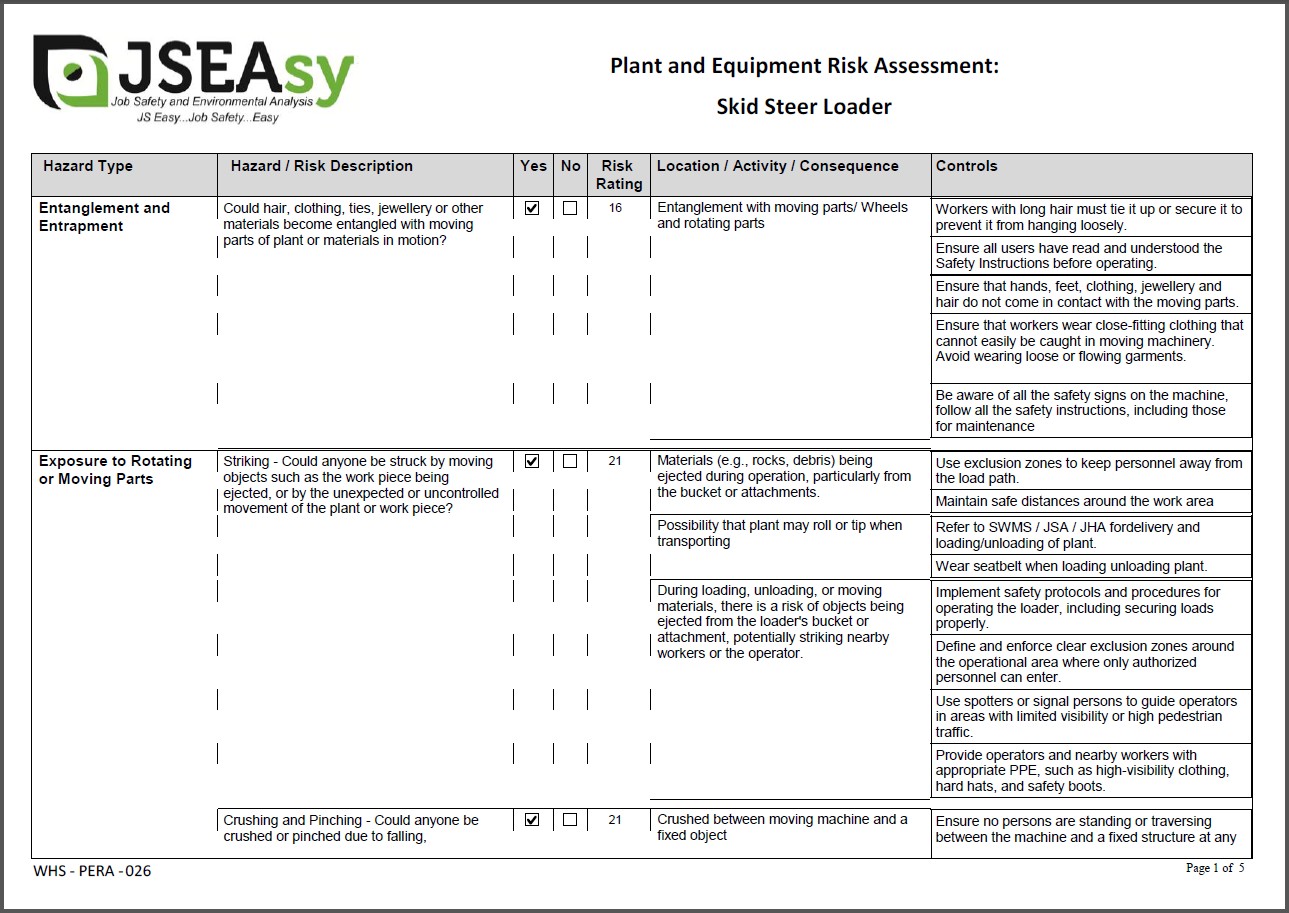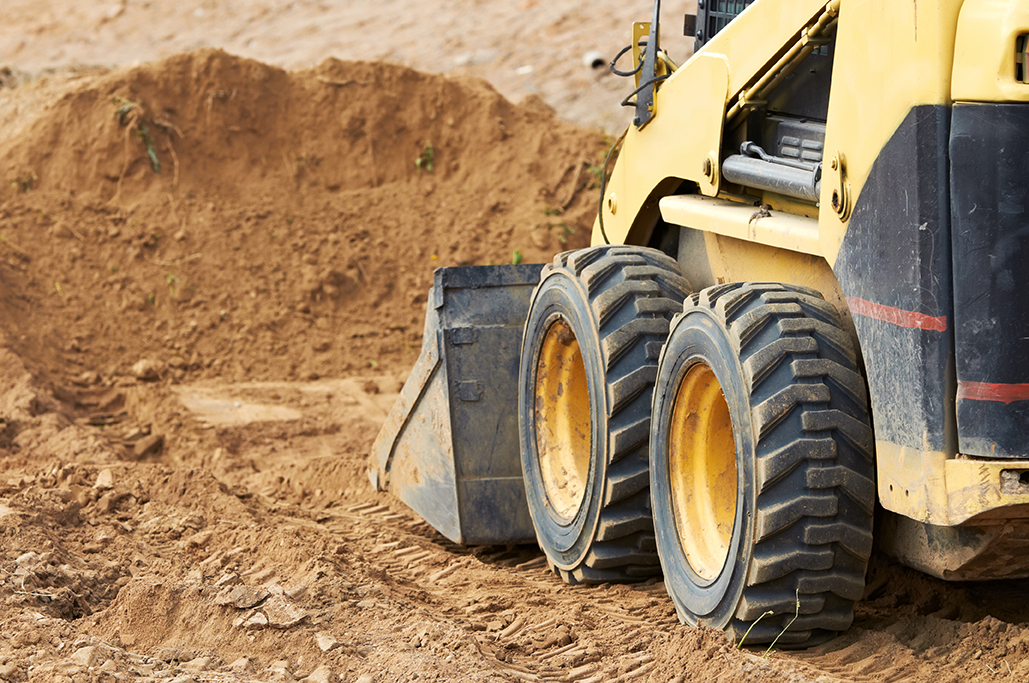Plant and Equipment Risk Assessment for Skid Steer Loaders
Introduction
The Skid Steer Loader is a versatile piece of equipment used across various industries. Ensuring its safe operation is critical to meet legal obligations and protect workers. Using JSEAsy EHS software, you can create comprehensive Plant and Equipment Risk Assessments (PERAs) tailored for Skid Steer Loaders. This standalone document is also available for instant download.
In Australia, Work Health and Safety (WHS) regulations mandate identifying and managing risks associated with plant and equipment. This PERA helps your operations align with Safe Work Australia guidelines and industry standards like AS/NZS 4024 (Safety of Machinery).
By conducting a thorough risk assessment, you prioritize the safety of operators, workers, and the environment while ensuring compliance with legal and industry requirements.
Identifying Hazards
The first step in risk assessment involves identifying potential hazards related to Skid Steer Loaders:
- Operational Hazards: Instability, tipping, collisions, or restricted visibility during operation.
- Loading and Unloading Hazards: Overloading, uneven weight distribution, shifting loads, or falling materials.
- Maintenance Hazards: Exposure to harmful substances, electrical risks, or injuries from heavy tools and equipment.
- Environmental Hazards: Adverse weather, uneven terrain, or confined spaces affecting safe operation.
- Human Factors: Inadequate training, operator fatigue, human error, or non-compliance with safety protocols.
Assessing the Risks
Once hazards are identified, assess their associated risks by considering:
- Severity: Potential outcomes, ranging from minor injuries to fatalities or environmental harm.
- Likelihood: The probability of an incident occurring (e.g., rare, possible, or likely).
- Risk Rating: Combine severity and likelihood to classify the risk as low, medium, high, or extreme.
Implementing Control Measures
Mitigate identified risks with the following control hierarchy:
- Elimination: Remove the hazard entirely (e.g., redesigning workflows).
- Substitution: Replace high-risk activities or equipment with safer alternatives.
- Engineering Controls: Use safety features like stability systems, non-slip platforms, and protective barriers.
- Administrative Controls: Enforce safety procedures, training programs, and scheduled maintenance.
- PPE: Equip workers with protective gear, such as helmets, safety boots, and high-visibility clothing.
Monitoring and Reviewing
Maintaining safety requires continuous monitoring and regular updates:
- Regular Inspections: Ensure the Skid Steer Loader and related equipment remain in safe operating condition.
- Incident Reporting: Encourage reporting of near-misses and hazards to refine safety measures.
- Periodic Reviews: Update the risk assessment to reflect changes in equipment, procedures, or regulations.
Specific Safety Considerations
Skid Steer Loaders present unique challenges that require additional precautions:
- Electrical Systems: Regularly inspect electrical components to prevent malfunctions.
- Loading Procedures: Avoid overloading and ensure proper load distribution and securement.
- Stability: Monitor stability on uneven ground and during lifting operations.
- Site Conditions: Evaluate terrain and address hazards like slopes, soft soil, or obstacles.
- Comprehensive Maintenance: Follow a maintenance program for hydraulics, brakes, and other critical systems.
- Operator Competency: Ensure operators receive adequate training and certification.
- Emergency Preparedness: Establish protocols for emergencies such as rollovers, mechanical failures, or accidents.
Conclusion
A detailed Plant and Equipment Risk Assessment for Skid Steer Loaders is vital for ensuring safety and operational efficiency. By systematically identifying hazards, assessing risks, and implementing robust controls, you can minimize accidents and maintain compliance with WHS regulations.
For expert guidance or to access our easy-to-use risk assessment tools, contact the JSEAsy team. Together, we’ll help you build a safer workplace.
Instant Download
This PERA is created using the JSEAsy EHS software and is delivered as a pdf document. We can add your logo/ Business details, the make and model of your equipment to make this PERA specific for your business at no additional cost. Just reply to our automated email after completing your purchase and send us the details. We will insert them and send you the document.
Need more customisation? just speak to us and we will see what we can do for you.
Want more control or more than one PERA or maybe some Safe Operating Procedures, Safe Work Method Statements, policies or procedures? The JSEAsy Safety Management Software has you covered.
Why Choose This Standalone PERA?
- Peace of Mind – Developed by WHS professionals to industry standards
- Instant Download – Access the document immediately
- Generated using the JSEAsy EHS Software – Seamlessly integrates into your Safe Work Method Statement (SWMS) library
- Saves Time – No need to write a risk assessment from scratch
Who Is This For?
This PERA is ideal for:
- Building Contractors
- Civil contractors
- Mining operations
- Subcontractors
- Hire companies
Document Format:
- Delivered in PDF format. We can add your logo and details of a particular make and model at no additional cost.
- Fully printable
- Includes risk matrix and risk ratings
Why do you need a PERA?
Under Australian WHS laws, employers and contractors are required to identify and manage risks related to plant and equipment. Skid steer loaders carry notable dangers due to their load handling, mechanical parts, and the environments in which they operate.
The requirements are outlined in the Managing risks of plant in the workplace code of Practice.
This PERA helps ensure your team works safely and your business remains compliant and audit-ready.
Ensure safety, compliance and peace of mind — in minutes, not hours.
With JSEAsy Plant & Equipment Risk Assessment Software, you can instantly generate WHS-compliant risk assessments, link them with SWMS and SOPs, and centralise all your plant registers and maintenance schedules. Designed for businesses managing any scale of machinery—from a single tool to full fleets—JSEAsy streamlines your safety workflows, reduces errors from paperwork, and keeps you audit-ready at all times
Need more than one PERA or other Safety Documents?
The JSEAsy EHS Software takes your safety management to the next level—allowing you to create, manage, and update SWMS, risk assessments, and other safety documentation all in one central platform. With built-in templates, version control, and cloud-based access, it’s designed to save time, improve consistency, and help your business meet ongoing WHS obligations with ease.
Key Features of JSEAsy Software
Preloaded SWMS, SOPs and Risk Assessments
Access a vast library of ready-to-use templates across construction, maintenance, and high-risk industries.- Fully Editable Templates
- Safe Work Method Statements (SWMS)
- Plant and Equipment Risk Assessments
- Safe Operating Procedures
Centralised Safety Documentation
Keep all your safety documents in one secure place—easily accessible on desktop or cloud (depending on plan).Project-Specific Job Packs
Automatically generate full WHS job packs including SWMS, risk assessments, training records, permits, and sign-off sheets.Version Control and Auto Updates
Maintain consistency and compliance as templates are updated with regulation changes.Staff and Contractor Management
Track inductions, licences, and competencies—ideal for small teams or larger subcontractor networks.Simple Interface
Intuitive menus and guided workflows make it usable even by those with limited admin or computer experience.Multi-user Access (Multiuser and Premium Version)
Collaborate across your team or sites with secure role-based access.


